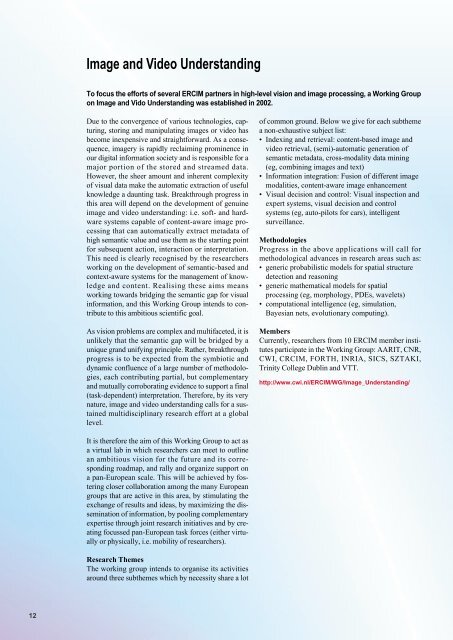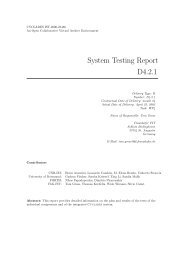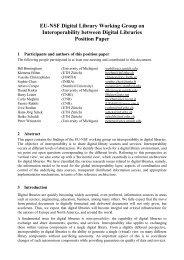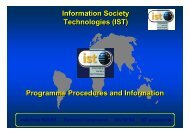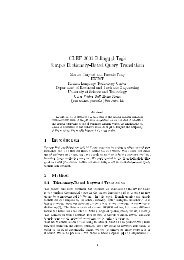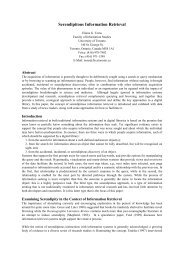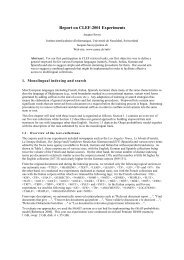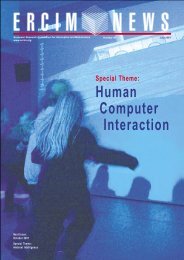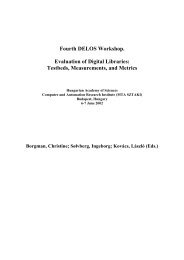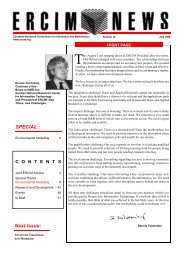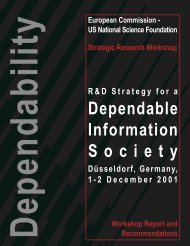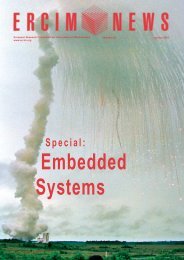Annual Report 2002 - ERCIM
Annual Report 2002 - ERCIM
Annual Report 2002 - ERCIM
You also want an ePaper? Increase the reach of your titles
YUMPU automatically turns print PDFs into web optimized ePapers that Google loves.
12<br />
Image and Video Understanding<br />
To focus the efforts of several <strong>ERCIM</strong> partners in high-level vision and image processing, a Working Group<br />
on Image and Vido Understanding was established in <strong>2002</strong>.<br />
Due to the convergence of various technologies, capturing,<br />
storing and manipulating images or video has<br />
become inexpensive and straightforward. As a consequence,<br />
imagery is rapidly reclaiming prominence in<br />
our digital information society and is responsible for a<br />
major portion of the stored and streamed data.<br />
However, the sheer amount and inherent complexity<br />
of visual data make the automatic extraction of useful<br />
knowledge a daunting task. Breakthrough progress in<br />
this area will depend on the development of genuine<br />
image and video understanding: i.e. soft- and hardware<br />
systems capable of content-aware image processing<br />
that can automatically extract metadata of<br />
high semantic value and use them as the starting point<br />
for subsequent action, interaction or interpretation.<br />
This need is clearly recognised by the researchers<br />
working on the development of semantic-based and<br />
context-aware systems for the management of knowledge<br />
and content. Realising these aims means<br />
working towards bridging the semantic gap for visual<br />
information, and this Working Group intends to contribute<br />
to this ambitious scientific goal.<br />
As vision problems are complex and multifaceted, it is<br />
unlikely that the semantic gap will be bridged by a<br />
unique grand unifying principle. Rather, breakthrough<br />
progress is to be expected from the symbiotic and<br />
dynamic confluence of a large number of methodologies,<br />
each contributing partial, but complementary<br />
and mutually corroborating evidence to support a final<br />
(task-dependent) interpretation. Therefore, by its very<br />
nature, image and video understanding calls for a sustained<br />
multidisciplinary research effort at a global<br />
level.<br />
It is therefore the aim of this Working Group to act as<br />
a virtual lab in which researchers can meet to outline<br />
an ambitious vision for the future and its corresponding<br />
roadmap, and rally and organize support on<br />
a pan-European scale. This will be achieved by fostering<br />
closer collaboration among the many European<br />
groups that are active in this area, by stimulating the<br />
exchange of results and ideas, by maximizing the dissemination<br />
of information, by pooling complementary<br />
expertise through joint research initiatives and by creating<br />
focussed pan-European task forces (either virtually<br />
or physically, i.e. mobility of researchers).<br />
Research Themes<br />
The working group intends to organise its activities<br />
around three subthemes which by necessity share a lot<br />
of common ground. Below we give for each subtheme<br />
a non-exhaustive subject list:<br />
• Indexing and retrieval: content-based image and<br />
video retrieval, (semi)-automatic generation of<br />
semantic metadata, cross-modality data mining<br />
(eg, combining images and text)<br />
• Information integration: Fusion of different image<br />
modalities, content-aware image enhancement<br />
• Visual decision and control: Visual inspection and<br />
expert systems, visual decision and control<br />
systems (eg, auto-pilots for cars), intelligent<br />
surveillance.<br />
Methodologies<br />
Progress in the above applications will call for<br />
methodological advances in research areas such as:<br />
• generic probabilistic models for spatial structure<br />
detection and reasoning<br />
• generic mathematical models for spatial<br />
processing (eg, morphology, PDEs, wavelets)<br />
• computational intelligence (eg, simulation,<br />
Bayesian nets, evolutionary computing).<br />
Members<br />
Currently, researchers from 10 <strong>ERCIM</strong> member institutes<br />
participate in the Working Group: AARIT, CNR,<br />
CWI, CRCIM, FORTH, INRIA, SICS, SZTAKI,<br />
Trinity College Dublin and VTT.<br />
http://www.cwi.nl/<strong>ERCIM</strong>/WG/Image_Understanding/


